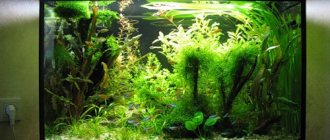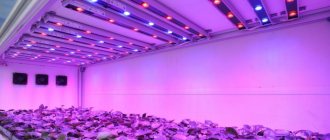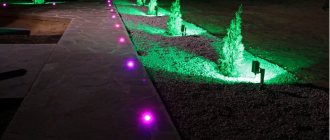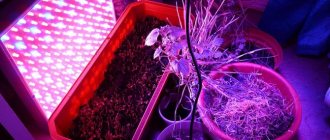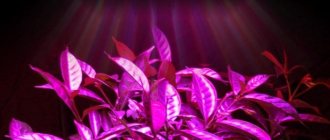Electrician in the house
Encyclopedia about electricity from A to Z
Masters catalog
Find the best master or company in your city
A real underwater garden in your home
In the recent Soviet past, people, due to the lack of diversity on television and the absence of the Internet, led full lives, reading a lot and devoting themselves to some hobbies. Aquariums were one of the most beloved and beautiful activities; the country had millions of amateurs and professionals.
Today, quantity has turned into quality, and a simple glass parallelepiped has acquired completely new, beautiful and unusual shapes. A large role in the correct organization of underwater life is played by the lighting of the aquarium for plants and fish, plus, lighting can make it a real work of art. We'll talk about this in today's article.
- Light in the aquarium Result of improper lighting
- Common Mistakes
- Main characteristics
Types of lamps
Lamps are divided into types, differing in energy consumption and power.
- Incandescent. The only pet for which this aquarium lighting is suitable is the land turtle. An incandescent lamp overheats the water and produces heat, which does not prevent the growth of algae and pathogenic bacteria. Good quality lamps are energy consuming.
- Luminescent. This is not the best way to properly illuminate an aquarium, but it is quite suitable for unpretentious creatures. Has low power.
- Metal halide. These lamps are a good option for aquariums. They are energy-efficient, small in size, have a long service life, and have high luminous efficiency. Metal halide lamps are similar to natural solar radiation, which has a good effect on the well-being of the inhabitants.
- LED. Suitable for most pets. They are comfortable in terms of aquarium light, durability, and have a wide spectrum of luminescence. The downside of these lamps is the high cost of quality products. It is produced not only in the form of lamps, but also as LED panels and spotlights.
More details about the types of lamps, aquarium lamps, and their characteristics are described separately.
Mistakes made by aquarists
Some aquarists install special aquarium lamps above the aquarium with peaks in the blue and red spectrum and at the same time increase daylight hours. Due to such actions, the plants begin to become covered with algae: threadwort, xenococus, Vietnamese, beard. To grow well, freshwater aquarium plants require broad-spectrum lighting with a color temperature of 6,500 to 8,000 Kelvin. Special lamps should only be installed when they are complemented by other light sources.
Characteristics of aquarium lighting
Basic power standards for lighting devices:
- 0.1-0.3 Watt per liter of aquarium. It is preferred to keep inhabitants with a nocturnal lifestyle, catfish. Of the plants, low power is suitable for Java moss, Vallisneria.
- 0.4-0.5 Watt/l. Plants will grow slowly in such a tank. Shade-loving plants should be planted, because other species will stretch towards the light source and become thin and weak.
- 0.5-0.8 Watt/l. This is the best option for a standard aquarium. The plants grow well and do not lack aquarium light.
- 0.8-1 Watt/l. This power is suitable for fish and plants living in constant direct sunlight. This indicator is also necessary for aquascaping and aquarium keeping with a larger number of plants.
DIY making
The first method involves additional arrangement of the lid using special phytolamps. LED equipment is attached over the entire surface of the lid. Thanks to this tape, the necessary light spectrum is created. Remove the protective film from LED material based on self-adhesive paper. The tape is attached to the entire surface of the lid and filled with plastic. At the junction of the cable and the tape, it is necessary to make insulation with silicone. This material reliably protects the cable from moisture. This type of lighting for plants, water and the entire aquarium world is used as decoration. These phytolamps cannot be called a separate light source.
The second method includes the main type of lighting without the use of multifunctional units. For large aquariums with a volume of 200-300 liters, lighting with a power of 115-125 W is required. You will need a little more than forty spot LEDs, each of which has a power of 3 W. Ultimately, the aquarium should have over ten thousand lumens of illumination. For such a volume, the lighting will be very bright. Therefore, novice aquarists are advised to carefully monitor the balance of the aquarium world. If there is an excess of lighting and the plants are growing strongly in the container, it is recommended to reduce the overall intensity. The price of electrical units and LEDs depends on the resellers selling this equipment.
What will you need?
- LED lighting kit;
- Plastic gutter more than two meters long;
- Electrical unit 12 W;
- Cable 1.5 mm wide;
- Cooling system or coolers;
- 40 connector sockets for LED equipment;
- A special cutter designed for processing holes;
Installation, assembly
- Depending on the length of the container, it is necessary to cut two pieces of plastic gutter;
- 20 holes are drilled at the bottom of the material;
- LED lamps are inserted into the holes and carefully secured;
- The lamps are connected to a 12 W electrical unit. At this stage, it is recommended to contact a specialist. A professional electrician can easily connect the lamps to the sockets. Beginner aquarists may confuse the polarity. This may cause a short circuit;
- Coolers are installed to cool the container. They are used when there is strong fumes or heating of the lid;
Video about installing LED lighting
Lighting selection
- When choosing equipment, select the intensity and saturation of light. To do this, the characteristics of the tank are taken into account: the number of fish, plants, tank volume, water salinity, amount of water.
- Selecting the lamp type. The impact on fish and cost depend on this choice.
- Choose underwater creatures and greenery with approximately the same light requirements. But you should focus on vegetation, it is this that releases oxygen into the water.
Underwater lighting
If there is a lack of light or additional lighting of parts of the tank, underwater lighting for the aquarium is used - a spotlight. An aquarium light consists of a hermetically sealed container and a bright light source inside. It comes in white, blue, red. Most often used for decoration, intentional lighting of underwater figures or other decor.
Color temperature, what is it and what is its meaning
Color temperature is the hue that a light bulb exhibits when heated. It is measured in Kelvin. For most aquatic decorative inhabitants, a lamp with a temperature glow of 6-20 Kelvin is considered a sufficient indicator.
Color temperature of lamps in Kelvin Source illuminated-mirrors.freshdesk.com
Experts recommend giving preference to devices with an indicator of 10 thousand Kelvin and above. This shade of radiation is more comfortable for fish and does not create stressful situations for them. The number of Kelvins in light temperature also depends on the volume of the tank. The larger the aquarium volume, the higher the indicator should be.
Where to place the lighting for the aquarium
Illumination and spotlights are located at the top next to other lamps or on the side walls. Less often, lighting is built into the ground or among greenery.
Number of lamps and their placement
For a small volume tank, one lamp with low power will be enough. But in large tanks you will have to equip two or three high-power lamps.
Lamps are usually placed on top, on the lid. It is also possible to place lighting in the aquarium on the sides of the walls.
Is it worth ordering lamps from Aliexpress?
Novice aquarists try to save money on purchasing a lamp for plants, which forces them to look for the product in Chinese stores, on the Aliexpress website. Of course, there are universal models there. However, they have disadvantages:
- Chinese LEDs are of low quality and are not intended for long-term use;
- light bulbs overheat quickly, which leads to combustion;
- The declared characteristics of the devices are greatly overestimated, so the use of intense light leads not only to the development of algae, but also to the death of vegetation.
A competent approach to choosing a lamp is required. After all, an incorrectly selected device will not only not provide a healthy microclimate in the tank, which will lead to negative consequences, but can be dangerous for the owner.
For beginners who want to grow plants in an aquarium and create exclusive living compositions, some advice would be helpful - take the time to fully study the material. It is better to spend months reading useful literature, slowly selecting the appropriate equipment and choosing the one on which the appearance of the entire aquarium composition will depend.
What kind of lighting is in your aquarium? What parameters were used to select it? Share your experience in the comments.
Light intensity
The intensity in the tank should be selected taking into account the specifics of the tank: what is the salinity of the water, how consuming are the plants, color, depth of the water. For these conditions, lamps with optimal lighting are selected.
Selection by volume
Having built the lighting based on the volume, you can change it to suit other conditions. It is important to take not the volume of the container itself, but the volume of water, without air, soil.
One liter in a standard tank requires 0.5-0.8 watts. This value varies depending on the needs of fish and vegetation.
Selection by depth
Selecting the depth of the aquarium lighting is problematic, because light is absorbed every 10 cm of water - 50% of the photons are scattered and do not reach the next layer. If there is good lighting at the top, only a small amount of light will reach the bottom. Therefore, the deeper the aquarium, the more powerful its lighting should be.
Options for controlling daylight hours.
Daylight control using instruments on the bottom panel.
To create the optimal light mode, you will need several lamps, each of which is regulated by a separate toggle switch.
For ease of use, you can automate the process of turning the backlight on and off. It is enough to build a temporary relay or timer into the circuit and program it.
A timer is the simplest control device. There are timers that are designed to work in an aquarium. You just need to install them and set the desired time to turn the lighting on and off. The advantage of the timer is that it works in real time. If you need to turn on the aquarium at 7-25, then this is the number you dial on the device.
Relays do not have this function. The control is set logically: the process will begin after the required time interval. (For example, turn on the light after 8 hours, and turn off after 10). But when there is a voltage drop in the network, the relay program does not get lost. Devices are divided into mechanical and electronic. In the latter case, the lighting intensity is programmed.
Control devices can be installed on an outlet or in a panel. The first method is cheaper and simpler. The second is possible only at the stage of laying the wiring; this reduces the number of wires.
You might be interested
How to choose an aquarium
Review of Laguna aquarium lights
Plants for the aquarium: tips for beginners
LED lamps and luminaires for aquariums: how to choose?

